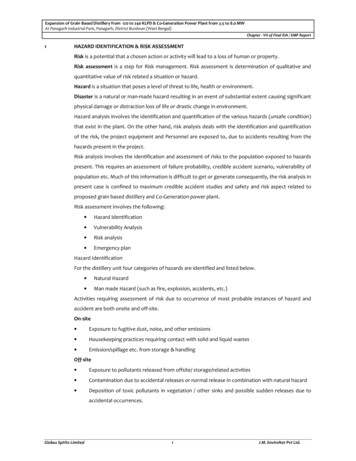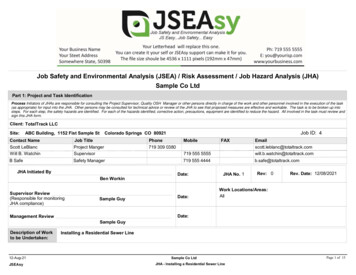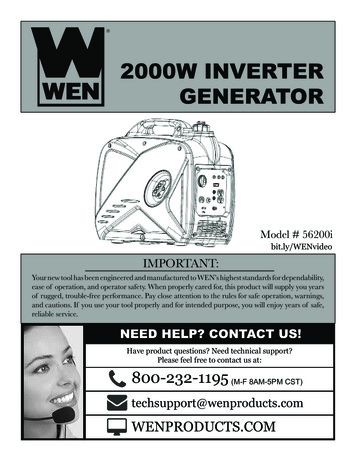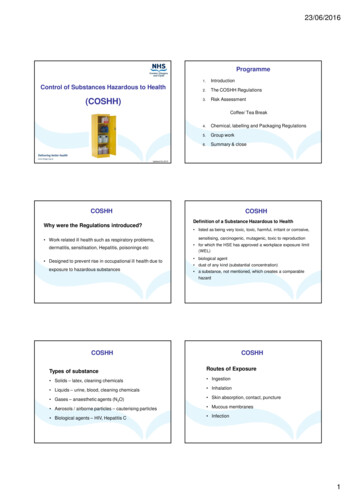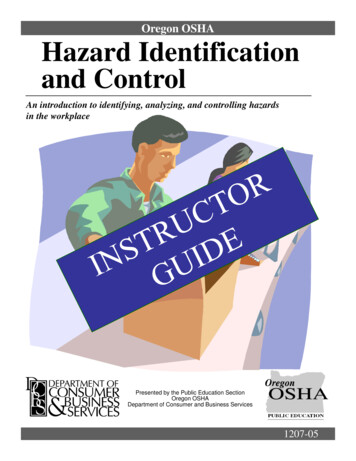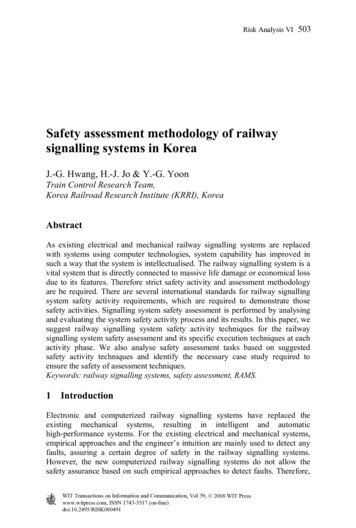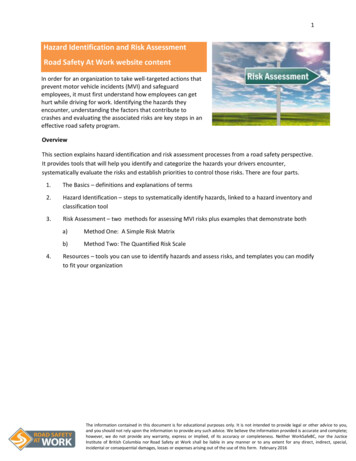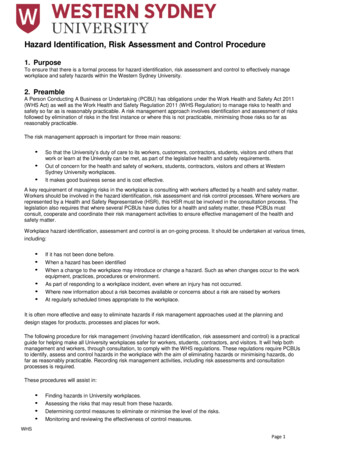
Transcription
Hazard Identification, Risk Assessment and Control Procedure1. PurposeTo ensure that there is a formal process for hazard identification, risk assessment and control to effectively manageworkplace and safety hazards within the Western Sydney University.2. PreambleA Person Conducting A Business or Undertaking (PCBU) has obligations under the Work Health and Safety Act 2011(WHS Act) as well as the Work Health and Safety Regulation 2011 (WHS Regulation) to manage risks to health andsafety so far as is reasonably practicable. A risk management approach involves identification and assessment of risksfollowed by elimination of risks in the first instance or where this is not practicable, minimising those risks so far asreasonably practicable.The risk management approach is important for three main reasons: So that the University’s duty of care to its workers, customers, contractors, students, visitors and others thatwork or learn at the University can be met, as part of the legislative health and safety requirements.Out of concern for the health and safety of workers, students, contractors, visitors and others at WesternSydney University workplaces.It makes good business sense and is cost effective.A key requirement of managing risks in the workplace is consulting with workers affected by a health and safety matter.Workers should be involved in the hazard identification, risk assessment and risk control processes. Where workers arerepresented by a Health and Safety Representative (HSR), this HSR must be involved in the consultation process. Thelegislation also requires that where several PCBUs have duties for a health and safety matter, these PCBUs mustconsult, cooperate and coordinate their risk management activities to ensure effective management of the health andsafety matter.Workplace hazard identification, assessment and control is an on-going process. It should be undertaken at various times,including: If it has not been done before.When a hazard has been identifiedWhen a change to the workplace may introduce or change a hazard. Such as when changes occur to the workequipment, practices, procedures or environment.As part of responding to a workplace incident, even where an injury has not occurred.Where new information about a risk becomes available or concerns about a risk are raised by workersAt regularly scheduled times appropriate to the workplace.It is often more effective and easy to eliminate hazards if risk management approaches used at the planning anddesign stages for products, processes and places for work.The following procedure for risk management (involving hazard identification, risk assessment and control) is a practicalguide for helping make all University workplaces safer for workers, students, contractors, and visitors. It will help bothmanagement and workers, through consultation, to comply with the WHS regulations. These regulations require PCBUsto identify, assess and control hazards in the workplace with the aim of eliminating hazards or minimising hazards, dofar as reasonably practicable. Recording risk management activities, including risk assessments and consultationprocesses is required.These procedures will assist in: Finding hazards in University workplaces.Assessing the risks that may result from these hazards.Determining control measures to eliminate or minimise the level of the risks.Monitoring and reviewing the effectiveness of control measures.WHSPage 1
3. DefinitionsHazard: Anything (e.g. condition, situation, practice, behaviour) that has the potential to cause harm, including injury,disease, death, environmental, property and equipment damage. A hazard can be a thing or a situation.Hazard Identification: This is the process of examining each work area and work task for the purpose of identifying allthe hazards which are “inherent in the job”. Work areas include but are not limited to machine workshops, laboratories,office areas, agricultural and horticultural environments, stores and transport, maintenance and grounds, reprographics,and lecture theatres and teaching spaces. Tasks can include (but may not be limited to) using screen based equipment,audio and visual equipment, industrial equipment, hazardous substances and/or teaching/dealing with people, driving avehicle, dealing with emergency situations, construction. This process is about finding what could cause harm in worktask or area.Risk: The likelihood, or possibility, that harm (injury, illness, death, damage etc) may occur from exposure to a hazard.Risk Assessment: Is defined as the process of assessing the risks associated with each of the hazards identified so thenature of the risk can be understood. This includes the nature of the harm that may result from the hazard, the severity ofthat harm and the likelihood of this occurring.Risk Control: Taking actions to eliminate health and safety risks so far as is reasonably practicable. Where risks cannotbe eliminated, then implementation of control measures is required, to minimise risks so far as is reasonably practicable.A hierarchy of controls has been developed and is described below to assist in selection of the most appropriate riskcontrol measure/s.Monitoring and Review: This involves ongoing monitoring of the hazards identified, risks assessed and risk controlprocesses and reviewing them to make sure they are working effectively.4. ResponsibilitiesEffective risk management requires the commitment to WHS from managers and Officer as well as the input andinvolvement of workers.It is the responsibility of all managers and supervisors to ensure that this policy is fully implemented in their area(s) ofcontrol and to consult with workers as part of undertaking the hazard identification, risk assessment and control process.It is the responsibility of workers to cooperate and comply with this policy. This includes providing effective andconstructive information and feedback to aid the risk management process.Officers have a responsibility to ensure that the areas under their control are complying with legislative requirements.This includes the Officer understanding the hazards and risks associated with their operations and ensuring thatappropriate resources and processes are in place to eliminate or minimise these risks.WHSPage 2
5. Risk Assessment ProcedureThe risk assessment procedure can best be illustrated in the following way.Step 1: Identify HazardsWHS legislation in New South Wales requires that PCBUs, in consultation with workers identify all potentially hazardousthings or situations that may cause harm. In general, hazards are likely to be found in the following;- Physical work environment,- Equipment, materials or substances used,- Work tasks and how they are performed,- Work design and managementIn order to identify hazards the following are recommended:(i) Past incidents/accidents are examined to see what happened and whether the incident/accident couldoccur again.(ii) Employees be consulted to find out what they consider are safety issues,I.e. ask workers about hazards near misses they have encountered as part of their work. Sometimes a surveyor questionnaire can assist workers to provide information about workplace hazards.(iii) Work areas or work sites be inspected or examined to find out what is happening now. Identifiedhazards should be documented to allow further action. The work environment, tool and equipment as wellas tasks and procedures should be examined for risks to WHS.(iv) Information about equipment (e.g. plant, operating instructions) and Material Safety Data Sheetsbe reviewed to determine relevant safety precautions.(v) Welcome creative thinking about what could go wrong takes place, i.e. what hazardous event could takeplace here?At the University, any hazard which is identified by this process should be recorded on the Risk Assessment andControl Sheet (see Attachment 1 to this document) and further action taken to assess and then control the risks fromthis hazard.WHSPage 3
Step 2: Assess RisksRisk assessment involves considering the possible results of someone being exposed to a hazard and the likelihood ofthis occurring. A risk assessment assists in determining:-How severe a risk is-Whether existing control measures are effective-What action should be taken to control a risk-How urgently action needs to be taken.A risk assessment should include:(i)Identify factors that may be contributing to the risk,(ii)Review health and safety information that is reasonably available from an authoritative source and isrelevant to the particular hazard,(iii)Evaluation of how severe the harm could be. This includes looking at the types ofinjuries/illnesses/harm/damage that can result from the hazard, the number of people exposed, possiblechain effects from exposure to this hazard.(iv)Evaluation of how a hazard may cause harm. This includes examining how work is completed, whetherexisting control measures are in place and whether they control the harm, looking at infrequent/abnormalsituations as well as standard operating situations. A chain of events related to a risk may need to beconsidered.(v)Determining the likelihood of harm occurring. The level of risk will increase as the likelihood of harm andits severity increases. The likelihood of harm occurring may be affected by how often the task is completed,in what conditions, how many people are exposed to the hazard and for what duration.(vi)Identify the actions necessary to eliminate or control the risk; and(vii)Identify records that it is necessary to keep to ensure that the risks are eliminated or controlled.Other risk factors should also be identified as they may contribute to the risk: including(viii)The work premises and the working environment, including their layout and condition,(ix)The capability, skill, experience and age of people ordinarily undertaking work,(x)The systems of work being used; and(xi)The range of reasonably foreseeable conditions.The process of assessing the risk is undertaken by reviewing any available information about the hazard (e.g. legislation,Australian Standards, Industry Code of Practice or guidance material about the hazard) and by using your personal workexperience about what sort harm the hazard could create and how likely this would be to happen. When determining howlikely it is that a person could be exposed to a hazard, consideration needs to be given to these “exposure factors”:(i) Whether there are any other risk factors that increase the likelihood of exposure?(ii) How often is the person exposed (frequency)?(iii) or how long is the person exposed (duration)?(iv) How many people are exposed?(v) the likely dose to which the person is exposed?(vi) any legislative or recommended exposure levels required by statutory authorities.WHSPage 4
At Western Sydney University we require managers and supervisors to identify hazards, assess the risks of harm resultingfrom exposure to the hazards and set a priority for corrective action by using a clearly laid out process. The process is asfollows:(i) Identified hazards are placed on the Risk Assessment and Control Form. (attachment 1)(ii) A Risk Category Table (below) is then used to categorise the type of risk to the universityRisk Category TableRisk CategoryDescriptionAcademic(Course load/logistics)Student load by course and campus, Staff student ratios, teaching loads,admission processes and standards, student progression and retention rates ,mode of delivery, changes of student profile and market demands, course and unitcoordination capacity and load of academics, levels of administrative and technicalsupport for academic course and unit deliveryAcademic(Course curriculum/ quality)Quality/ standard of academic program/ course contents, planning strategyfor course offerings, approvals and monitoring process for courses and unitsAcademic(Research)Research income, research load, research work and staff, researchcapacity, Intellectual property, patents, ethical conduct in research etc.BehaviourUniversity community’s risk culture: staff & students’ reckless (disasters),conservative (opportunities lost), observation of policies and procedures. Studentdemonstrations, terrorism, fraud, corrupt conduct, activists seeking to damage theUniversity.EnvironmentalWater, soil, air contamination, asbestos, waste management, incidentscausing damages, injury/ death, environmentally triggered emergencies.FinancialReductions in income, liquidity, financial loss, insurances, debt, budgetoverruns, tenders.InfrastructureThe physical fabric of the University, buildings, roads, pathways, utilities(electricity, water).InternationalOverseas ventures/ reputation/ program disaster, relationships withoverseas universities.LegalContracts and agreements, high profile litigation - financial and reputationalimpact.LegislationBreach, financial penalty/ impact on reputation, laws, regulations, codes,affecting the University.OrganisationStrength of policies and procedures, planning, staffing, morale, training,ethical culture, leadership and management.PoliticalAbility to respond to major changes in education policies, level ofgovernment consultation.Damaging media reports, employability of graduates, research links,regional ogyStrategic direction of IT, reliance on ecommerce/ email/ internet, studentrecords system, library.(iii)The Risk Ranking Matrix is used to assess the likelihood and the severity or consequences of eachhazard and to give it a “risk rating”.WHSPage 5
Risk Rating MatrixLikelihood (L)Consequences UnlikelyPossibleVery LikelyCertain to ighvery lowlowmoderatemoderatemoderatevery lowvery lowlowlowmoderateConsequences(C)CatastrophicDeath or permanent disabilityMajorSerious injury, hospital treatment requiredModerateInjury requiring medical treatment and some lost timeMinorMinor injury, first aid only requiredInsignificantLikelihood(L)Certain to OccurInjuries requiring no treatment or first aidVery LikelyWill probably occur in most circumstancesPossibleMight occur occasionallyUnlikelyCould happen some timeRareMay happen only in exceptional circumstancesHow Severely Could Someone be Hurt?How Likely are the Consequences?Expected to occur in most circumstancesActions RequiredRisk Level RatingRequired ActionHighImmediate action needed. Access to the hazard should be restricted until the risk can belowered to an acceptable level. Short term action may be required to lower the risk level andthen medium and long term plans to control the risk to as low as reasonably practicable usingthe Hierarchy of Controls.Action needed quickly (within 1-2 days). The task should not proceed unless the risk isassessed and control options selected based on the Hierarchy of Controls.ModerateAction required this week to eliminate or minimise the risk using the Hierarchy of Controls.LowAction required within a reasonable timeframe (2-4 weeks) to eliminate or minimise the riskusing the Hierarchy of Controls.Very LowRisk to be eliminated or lowered when possible using the Hierarchy of Controls.CriticalStep 3: Controlling RisksOnce a risk rating is determined, each hazard must have its existing risk control measures evaluated using theEvaluation of Control Effectiveness Table. This allows for determination of any additional requirement necessary.Evaluation of Control Effectiveness TableWell Designed Control ?Effectively Implemented ?3Needs improvement3Deficient (b)2Adequate2Marginal1Strong1EffectiveWHSPage 6
Step 4: Implement additional risk controlsHaving identified the hazards in your workplace, assessed their risks and reviewed the existing controls, all hazardsmust be managed before people are hurt, become ill or there is damage to plant, property or the environment.The management of risks in the workplace requires eliminating risks so far as reasonably practicable in the firstinstance. Where elimination is not possible, then risks should be minimised, so far as reasonably practicable.All hazards that have been assessed should be dealt with in order of priority. The most effective control option/sshould be selected to eliminate or minimise risks. The Hierarchy of Controls (see diagram below) ranks control optionsfrom highest level of protection and reliability to lowest. This should be used to determine the most effective control/s.Hierarchy of ControlsLevel 1 Control Measures – Eliminate the HazardThe most effective control measures eliminate the hazard and associated risks. This can be achieved through removingthe hazard or selecting alternate products or equipment to eliminate the risk. If a hazard cannot be eliminated then riskscan be minimised by lower control measuresLevel 2 Control MeasuresThese are used to minimise the risks and involve on or a combination of the following;(i) Substitute the hazard: substitute a substance, method or material toreduce the risk or the hazard(ii)Isolate the hazard: separate the hazard from the workplace or people, For example;a. Chemical store room, or a laboratory kept locked except to anauthorised person.b. Lock out procedures on faulty equipment.c. Appropriate guarding for machinery.WHSPage 7
(iii)Use engineering controls: modify existing machinery or plant orpurchase different machinery or plant to provide a physical solution. For example;a. Trolleys, hoists or cranes.b. Guard rails.Level 3 Control MeasuresThese are control options which should be considered last as they do not control the source of the hazard but rely onhuman behaviour or supervision and are therefore less effective. They include;(iv) Administrative Procedures: develop work methods or procedures toreduce the conditions of risk, for example:a. Written Safe Operating Proceduresb. Job rotation to restrict hours worked on difficult jobs.c. Staff trained in the correct operating procedures.(v) Use Personal Protective Equipment (PPE) and training in its use:offer the lowest level of protection and should only be used as a last resort to deal with the hazard, wherethe hazard cannot be removed or reduced by any other means, for example:a. Handling of chemicals – gloves, safety glasses, aprons.b. Protecting eyes from flying particles.c. Protecting feet – safety boots.Consultation with workers is required in the selection and implementation of control measure in the workplace.Controls may need to be trialled to determine effectiveness and workers should be involved in the feedback process.Each measure must have a designated person and date assigned for the implementation of controls. This ensuresthat all required safety measures will be completed and documented.Step 5: Monitor and ReviewHazard identification, risk assessment and control is an on-going process. Therefore, regularly review the effectivenessof your hazard assessment and control measures at least every 3 years. Make sure that you undertake a hazard andrisk assessment when there is a change to the workplace including when work systems, tools, machinery or equipmentchange. Provide additional supervision when new employees with reduced skill levels or knowledge are introduced tothe workplace. The effectiveness of control measures can be checked through regular reviews as well as consultationwith workers.Maintaining records of the risk management process assists when undertaking subsequent reviews or riskassessments as it demonstrates decision making processes and informs how controls were intended to beimplemented.WHSPage 8
Page 2 . 3. Definitions. Hazard: Anything (e.g. condition, situation, practice, behaviour) that has the potential to cause harm, including injury, disease, death, environmental, property and equipment damage. A hazard can be a thing or a situation. Hazard Identification: This is the process of examining each work area and work task for the purpose of identifying all
